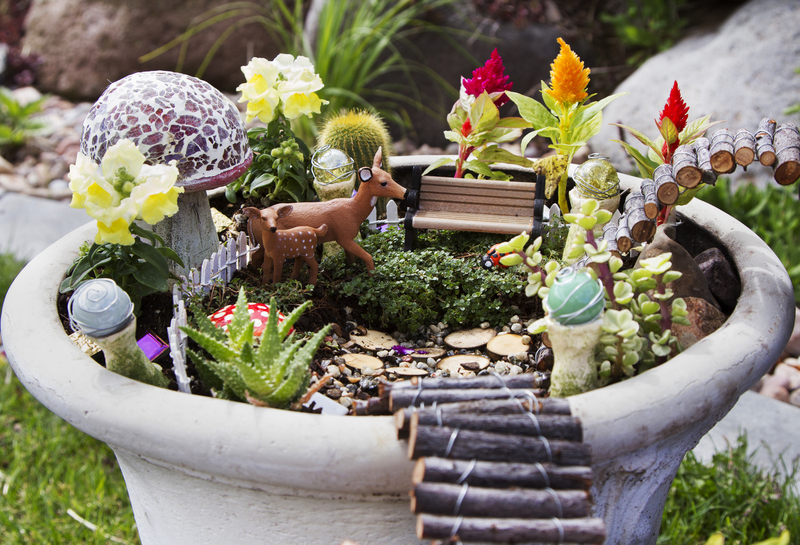Vertical Gardening: A Blossoming Trend
Posted on 05/09/2025
Vertical Gardening: A Blossoming Trend
Vertical gardening has rapidly emerged as one of the most innovative and eco-friendly approaches to urban horticulture. With urban spaces shrinking and the call for sustainable living growing ever louder, this technique is capturing the imaginations of gardeners, designers, and city dwellers alike. In this comprehensive article, we'll explore why vertical gardens are flourishing, how you can start your own, and the many advantages this blooming trend brings to homes and cities worldwide.

What is Vertical Gardening?
Vertical gardening is the practice of growing plants on upright surfaces such as walls, fences, screens, or specially designed supporting structures. Unlike traditional, ground-based gardening, vertical planters allow you to maximize space by stacking plants upward, creating lush living walls or verdant towers. This unique gardening method has evolved from simple trellises for climbing plants to highly engineered, soil-less green walls gracing skyscrapers.
The Rise of Vertical Gardens: Why is This Trend Blossoming?
The popularity of vertical gardening techniques can be attributed to several compelling factors:
- Limited urban space: With living quarters and yards becoming smaller, vertical planters allow gardeners to nurture plants even in the tightest spaces--balconies, patios, and kitchen walls.
- Environmental consciousness: Green walls help combat air pollution and mitigate the "urban heat island" effect by insulating buildings and filtering the air.
- Aesthetic appeal: Vertical gardens create striking visual features, transforming bland walls into vibrant, living tapestries.
- Fresh produce at hand: Reap the rewards of homegrown herbs, veggies, or fruits--even in a city apartment.
- Mental well-being: Being close to greenery has been proven to reduce stress, boost mood, and enhance productivity.
Types of Vertical Gardens
Not all vertical gardens are created equal. Here are five popular types you can try as a beginner or a seasoned plant enthusiast:
1. Trellises and Arbors
These classic structures support climbing plants like cucumbers, beans, peas, and flowering vines. Trellises are ideal for small gardens or patios.
2. Living Walls (Green Walls)
Arguably the most stunning form of vertical gardening, living walls are engineered frames that support dozens--or even hundreds--of plants in pockets or containers. With automatic irrigation and careful design, these botanical walls can thrive both indoors and outdoors.
3. Vertical Planter Towers
Modular towers, made from stacked pots or recycled plastic pipes, can host a variety of flowers or edible plants. These are excellent for patios and rooftops.
4. Pocket Planters and Shoe Organizers
Fabric pockets or upcycled organizers are budget-friendly options for herbs or succulents. Simply hang and fill each pocket with soil and seedlings.
5. Hydroponic Vertical Gardens
Using soil-less technology and nutrient-rich water, hydroponic systems allow crops to grow vertically--fast and efficiently. This high-tech solution is gaining traction with urban farmers and restaurants.
Key Benefits of Vertical Gardening
Whether you're cultivating a kitchen herb wall or overseeing a large commercial installation, vertical gardening methods offer a range of significant benefits:
- Maximizes small spaces: You can grow more plants in less square footage by utilizing height.
- Reduces disease and pest risk: Growing plants off the ground improves air circulation and decreases problems from soil-borne pests.
- Improves air quality: Living plants absorb CO2 and release oxygen, providing a natural air filtration system.
- Acts as natural insulation: Green walls insulate buildings, reducing energy consumption for heating and cooling.
- Enhances privacy and soundproofing: Lush wall planters can serve as both sound barriers and natural screens.
- Easy maintenance and harvest: Accessing plants at eye-level is easier for pruning, watering, and harvesting compared to traditional beds.
How to Start Your Own Vertical Garden
Ready to transform a blank wall or bare balcony into a thriving vertical garden? Here is a step-by-step guide to design and maintain your own vertical gardening system:
1. Plan Your Space
- Location: Choose a wall or surface that receives the necessary sunlight for your chosen plants.
- Weight and Support: Ensure the wall or structure can support the weight of soil, plants, and water.
2. Choose the Right Plants
- Light requirements: Match plants to the available sun or shade.
- Growth habit: Vines or trailing plants excel in vertical systems. Compact or bushy crops can also work well.
- Edible vs. ornamental: Select based on your goal--fragrant herbs, leafy greens, succulents, or flowers.
3. Select a Vertical Gardening Structure
- Prefabricated modular panels or kits are simple to install for beginners.
- DIY enthusiasts can build custom solutions from recycled pallets, PVC pipes, or fabric pockets.
4. Install Irrigation
- Drip irrigation or self-watering systems help automate moisture supply and reduce maintenance.
- Hand-watering is feasible for small walls but requires diligence and care.
5. Feed and Maintain
- Use high-quality, lightweight potting mix suitable for wall planters.
- Fertilize regularly and monitor for pests or diseases.
- Prune and replant as needed to keep your garden healthy and attractive.
Best Plants for Vertical Gardening
Selecting the right species is crucial for the success of your vertical garden project. Consider these popular choices:
- Herbs: Basil, thyme, oregano, chives, parsley, mint
- Leafy greens: Lettuce, spinach, Swiss chard, kale
- Vegetables: Cherry tomatoes, peppers, dwarf peas, beans, cucumbers
- Flowers: Petunias, nasturtiums, morning glories, begonias, pansies
- Succulents: Sedum, echeveria, jade plants, string of pearls
- Air plants (Tillandsia): Require no soil and can be attached directly to surfaces
- Shade tolerant options: Ferns, pothos, philodendron, English ivy
Challenges & Solutions in Vertical Gardening
While vertical gardening offers numerous benefits, it also presents unique challenges:
Water Management
- Walls can dry out quickly. Use moisture-retentive soil and install a drip-irrigation system for consistent hydration.
Structural Concerns
- Make sure your structure is sturdy. Use lightweight materials to minimize load on walls, especially indoors.
Pest and Disease Control
- Monitor regularly for infestations. Good airflow and rotating crops can help prevent problems.
Plant Selection & Replacement
- Some plants may outgrow their spot or require replacement. Choose species with compact roots and similar growth habits for uniformity.
Inspiring Examples of Vertical Gardens Around the World
Several large-scale vertical garden installations have become icons of urban sustainability and creative architecture:
- Musee du Quai Branly, Paris: Renowned botanist Patrick Blanc's 800m2 living wall, home to over 15,000 plants.
- Bosco Verticale, Milan: Two residential towers covered in 800+ trees and 15,000 plants, improving air quality and biodiversity.
- Changi Airport, Singapore: The Jewel's lush indoor green walls and the world's tallest indoor waterfall create a stunning garden oasis.
- One Central Park, Sydney: This apartment building features a vertical garden with over 35,000 plants that shade and filter the air for residents.
Sustainability Impact of Vertical Gardening
Embracing vertical gardening systems is not just about trendy aesthetics. These gardens play a key role in building environmentally responsible cities:
- Cooler cities: Plant-covered walls naturally reduce surface temperature and cool surrounding environments.
- Improved biodiversity: They provide habitat and food sources for pollinators, birds, and beneficial insects.
- Rainwater absorption: Vertical gardens absorb and slow down rainwater, decreasing urban flooding.
- Reduced carbon footprint: Growing food at home or locally in urban settings cuts food miles and packaging waste.
Frequently Asked Questions About Vertical Gardening
Do vertical gardens require a lot of maintenance?
Maintenance requirements vary depending on plant choice and system complexity. Simple pocket planters with herbs need minimal attention, while large automated living walls may need professional care. The key tasks include watering, pruning, feeding, and occasional replanting.
Can I build a vertical garden indoors?
Absolutely! Indoor vertical gardens are perfect for homes and offices. Choose plants that thrive in lower light and ensure you have a waterproof backing or tray to catch excess water.
Is vertical gardening expensive?
Costs can be minimal with DIY solutions like pallet gardens or shoe organizers. More advanced systems with irrigation and lighting will cost more but offer larger and more intricate displays.
What is the best vertical gardening method for beginners?
Start simple--with wall-mounted herb planters or a small trellis for climbing vines. As you gain confidence, you can expand to more ambitious structures or living walls.

Expert Tips For Successful Vertical Gardening
- Design with diversity--combine colors, textures, and heights for visual interest.
- Group plants with similar needs (sun, water, soil) to simplify care.
- Inspect frequently for pests, disease, or dry soil conditions.
- Feed and water regularly, but avoid overwatering, which can lead to disease.
- Rotate crops seasonally for fresh growth and continuous harvest.
Conclusion: The Future is Vertical
From compact balconies to towering skyscrapers, vertical gardening is inspiring a green revolution in urban and suburban environments. Not only does this blossoming trend make horticulture accessible for everyone, but it also offers practical and environmental benefits that traditional gardens cannot. Whether you're an experienced gardener or just starting out, there's never been a better time to explore the vertical dimension of gardening.
Ready to create your own living wall? With a bit of creativity and attention to detail, vertical gardening can transform even the smallest spaces into flourishing, verdant escapes--and help build a more sustainable world, one wall at a time.

